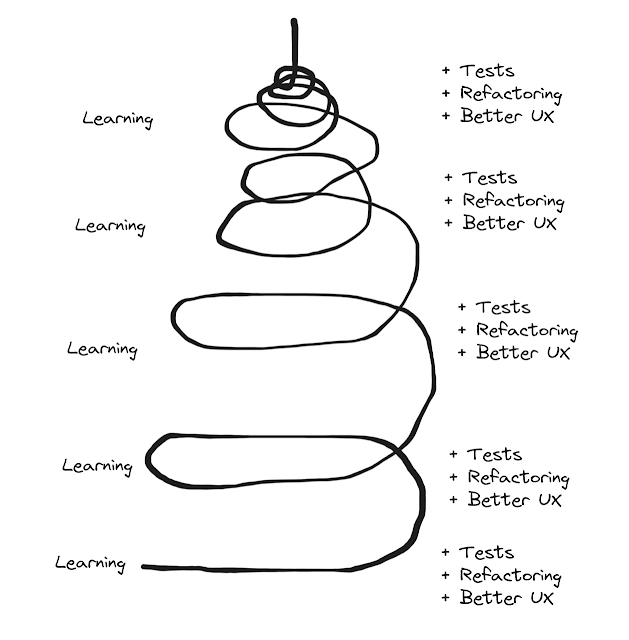Continuous Refactoring
Human Nature
More than 20 years ago when I started in the industry, I remember my first teacher talking about mindset. He was telling me a fable about Pigs. The tale was about a tribe of people who like to enjoy pork bbq, however, they have a rather peculiar method of doing the bbq.
What they did was literally burn the whole forest, after the fire was done, they would go to the forest and look for pigs, some might be a bit well-done, beyond the point, some might be too raw, and eventually, some would be ideal. Such process was always how they rolled, however, things were getting harder and harder since Forrest was not infinite and they had to travel far and far to find a new forest to throw fire. Eventually, a guy invented a bbq grilled with fire on the ground, this was a breakthrough innovation because now they were not required to burn the whole forest anymore. However, people did not like it and did not follow and still wanted to continue to burn the forest.Human nature has the tendency to get used to how things are, good or bad. The human being gets used and to break such cycles and addictions is difficult but is possible. Sometimes because they don't know any better, other times just because that was "the standard". However, humans can change and learn but is a process, it's a long-term commitment, that takes time, energy, patience, and love.
Driving fear out
One thing that leadership needs to do is to Drive fear out. Engineers have a fear of touching somebody else code because they want to succeed and do not like to fail meaning they do not want to upset their managers. Management often sees refactoring as a risk and something that should be avoided because might affect deadlines. What engineers want the most is to do refactoring, it's to change software and make it better. However we won't do anything if we have fear, that's why we need to drive this fear out and create an environment where the culture of change can flourish.
Such culture can be created by simple but yet courage acts like:
- Do some refactoring as part of the current PR
- Create a refactoring story and negotiate to add to your current sprint
- Ask for some refactoring as part of the code review process
- Give time for engineers to make improvements, even if is just 1 day per sprint
- Push back when the complexity is too high
- Talk about such improvements in retrospective
Netflix has this interesting concept: "Do not please your manager". We need to do what is best for the customers and for the company, seasoned engineers will push back management when does not make sense. However at the same time, engineers do not own the truth, they can be wrong as well, or they might want to refactor something that will be decommissioned or bring zero return for the company, that's why conversations need to happen.
The problem with this engineering mentality is that you don't create critical thinking, you don't create curiosity and you put all responsibility for improvements on managers, and that cannot scale and will not end well. Systems are big and complex, everybody needs to be collaborating and working hard to improve them.
Engineers are not and cannot be "Victims" they need to be adults behave like grow-ups and do their best no matter what. Managers need to support engineers and give good advice, one good advice is to do Refactoring.
Negative reinforcing loops
The problem with not doing refactoring is that little by little the system is dying and will become a legacy full of problems inefficiencies, bottlenecks, and anti-patterns and will need to be re-written eventually. Even if you start with a green field and are doing all the right things, people change, people come and go, management changes, companies change and if you stop improving you will start a decay process. All software suffers from this and that's how we create systems that suck.
Such doom downward spiral happens because often when you are not doing refactoring you are also not doing tests, not improving the coverage, not adding tesing diversity and diversification. The design tends to decay (if ever existed), libraries and frameworks get deprecated, does not take long to anti-patterns be everywhere and they will proliferate faster than the good things. Because if you don't do refactoring, you are not doing the good things.
The year was 2007, I was working in a big company in Brazil, and we were building a complex and important financial system, I remember the CEO of the company just wanted one thing "A system that lasts for years" he was already sick of re-writing everything over and over.
You can't get everything right all the time, mistakes happen, especially at full speed, but you need to learn as you learn you need to apply this learning, and that is how we create a different reality.
Positive reinforcing loops
We need to do refactoring because we need to keep the system alive, we need to make it better, this is how we will reverse this doom-down spiral to a positive reinforcement loop. The mindset is like this:
As we learn:- How to be better engineers
- How the business works
- How to better deliver value to the customer
- How we can make better designs
- How we can improve efficiency
We do add tests and do refactoring, resulting in better software, which results in a better digital product that will deliver better experiences for our users. UX is also about engineering:
- If the site/app is down, the user cannot do anything.
- If the site/app is slow the user will suffer
- If the site/app is confusing and not reliable the user cant trust us
Throwing salt or just adding balance...
As you can see there are multiple theories converging on this idea that you really need to do refactoring. One of the cool things about Tidy First is that Kent gives some criteria for when to refactor now, later, or even never. One thing he mentions is that there is a "promise" or a "gamble" and that's the refactor dilemma, you don't know if you will make it better or worse. So how do you know you will deliver something better, I was thinking about that and a couple of things come to my mind:
- Architecture is also a gamble, how do you know it will scale and deliver what you really think - that links us with evolutionary architecture and lean principles like reducing batch sizes, to reduce the change it goes wrong.
- Tests (I think we should do them) but they are also a gamble, they might not payoff, in fact if they are breaking all the time, they add negative value, there is nothing worse them tests that you cannot trust.
- Feature should be the same as Refactorings - they are also a gamble, how do we know if they will pay off or not (Discovery process) - but often we don't question why we are doing feature but we question why we are doing refactoring.
Pride
Edward Deming, an 80s quality guru and big influencer of his management theories in Japan post-WWII inspired Lean Thinking and Lean manufacturing. Always said: "People just want to feel pride". Pride about their jobs, pride about the things they build. It's not that complicated, is very simple in fact.
Refactoring is one of the best ways to boost engineers' pride at work if not the very best.
Continuous Refactoring building a culture of excellence
Cheers,
Diego Pacheco










